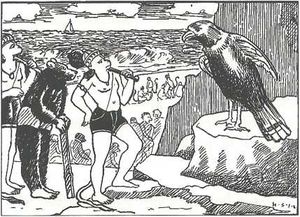Sampāti
From Hindupedia, the Hindu Encyclopedia
By Swami Harshananda
Sampāti and Jaṭāyu, the two great eagles mentioned in the Rāmāyaṇa, were brothers and were the sons of Aruṇa, the charioteer of Sūrya.[1] Once both of them started flying towards the sun. As they flew nearer the sun, the heat became so intense that it became unbearable. Sampāti, to protect his younger brother Jaṭāyu, spread his wings over him thereby getting them burnt.
When the sage Candra heard his story, he told him that he would get back his wings when he would reveal the place where Sītā was kept to the monkey army of Rāma. This he did and got back his wings.
References[edit]
- ↑ Sūrya means the Sun-god.
- The Concise Encyclopedia of Hinduism, Swami Harshananda, Ram Krishna Math, Bangalore

